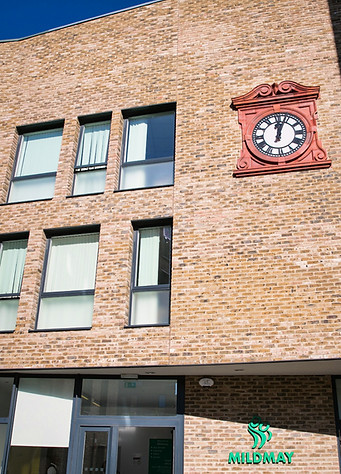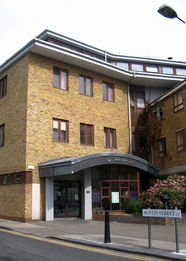
Mildmay’s story starts in the 1860s with Catherine and
William Pennefather.
The Reverend William and Catherine Pennefather developed a number of projects known collectively as Mildmay Institutions, providing spiritual guidance and care for the sick.
In 1866 there was a cholera outbreak in East London. Two Mildmay Deaconesses, trained in nursing by Catherine, volunteered to go into the Old Nichol, in the East End of London - one of the most notorious slums of the nineteenth century, where even the police feared to enter, to care for the sick and their dependents.
Although the water-borne transmission of the infection was understood, effective treatment remained elusive. Eventually, the epidemic subsided, but the Deaconesses continued their daily efforts and the principle of training nurses and caring for those most in need was established for the first time.

Mildmay Hospital: from our Historic Beginnings to Modern Care
This poster, created to mark the naming of the Mildmay line in 2024 and to celebrate our historic links with St Jude and St Paul's Church in Islington, captures the journey of our organisation from its origins in the1860s to the present day. It highlights key milestones, such as our founding by the Pennefathers; the Revd. William and
his wife Catherine, during the cholera epidemic, our transformation into Europe’s first AIDS hospice in the 1980s, and our current role in caring for homeless and marginalised communities as well as continuing to provide our life-changing HIV services.


Reverend William Pennefather was the vicar of St Jude and St Paul's, which is located in Mildmay Park, Islington. It was a lively Victorian church of over 1,000 people in Pennefather's day and still plays an active and important part in its local community.
Did you know
St Jude is the patron saint of hospitals and hopeless causes.
This compassionate response to the cholera outbreak laid the foundation for Mildmay’s first nursing service, shaping the ethos of reaching out to those in greatest need—an approach that continues to guide us to this day.
As well as cholera, typhus was also rife in the slums of the East End, as related in an article in the first edition of the East London Advertiser, launched in the same year.
The work of the deaconesses developed and expanded. In 1877, the first Mildmay Medical Mission was established in a disused warehouse in Cabbage Court (now Bacon Street, south of Bethnal Green Road).
It consisted of twenty-seven beds in three wards, one doctor, three nurses and five deaconesses in training. This was the first embodiment of what was soon to become Mildmay Mission Hospital.


The Old Nichol was situated between Shoreditch High Street and Bethnal Green Road.
It consisted of 20 narrow streets containing 730 dilapidated terraced houses which were inhabited by some 6,000 people.
The London County Council decided to clear the Old Nichol slums in the 1880s as part of the Bethnal Green Improvement Scheme and it was replaced by one of the earliest social housing developments in Britain, the Boundary Estate.
Rubble from the demolished slums was used to build an elevated bandstand that forms the centrepiece of Arnold Circus. Also around this time Charles Booth, a pioneer of social research, conducted an extensive survey of living conditions in London, publishing maps, colour coded according to the wealth of an area. He coloured the Old Nichol in black, the bottom of the scale, the poorest and most crime-ridden.

Above: the location of the 1892 Mildmay Mission Hospital on Booth's London Poverty map of 1889.

Arnold Circus on the Boundary Estate. The bandstand is yet to be completed.

The Old Nichol
%20DETAIL_LO.jpg)
Detail showing the original Mildmay Mission Hospital's location in relation to the site of the Old Nichol
_LO.jpg)
Part of the Ordnance Survey map (1893-1896) showing the site of the former Old Nichol

The Boundary Estate (Arnold Circus)

The first purpose-built
Mildmay Mission Hospital was opened in 1892

One of few artefacts we retain from the first hospital is our clock, positioned above the main entrance, just as in 1892.
1948: Mildmay becomes part of the NHS

Anenurin Bevan, Minister of Health, on the first day of the National Health Service, 5 July 1948 at Park Hospital, Davyhulme, near Manchester.
A significant event took place in British history in 1948, with the birth of the National Health Service.
This revolutionary system ensured everyone had access to healthcare. Britain was the first Western country to offer free at the point of use medical care to the whole population.
In 1948, Mildmay became part of the NHS, continuing its legacy of service and training within the broader healthcare system.
It was incorporated into the National Health Service as part of the North East Metropolitan Regional Board's Central (No. 5) Group of Hospitals and transferred in 1966 to the East London Group. In 1974 it became part of the Tower Hamlets Health District.

Nurse training certificate from 1951 (click to enlarge)
Mildmay's fight for survival
A working group set up by Tower Hamlets Health Authority in 1980 examined the position of Mildmay in relation to the needs of the community. By 1982, as a hospital with less than 200 beds, Mildmay was regarded as uneconomic and, along with many other 'cottage hospitals', was closed.
Mildmay’s Trustee Board, under the Chair, Helen Taylor Thompson, and with many loyal supporters, began the fight for Mildmay's survival.
After many setbacks, approval was given by Government and the NHS for Mildmay to reopen in 1985. In 1988, at the height of the AIDS epidemic, Mildmay was asked by the government to accept patients with AIDS and became Europe’s first hospice caring for people with AIDS-related illnesses.
An article about Mildmay from the East End Life newspaper, May 1995. (Click to enlarge)

Diana, Princess of Wales
Diana, Princess of Wales, visited Mildmay 17 times - both officially and unofficially - from 1989 until her tragic death in1997, and famously shook hands with a patient at the height of fear around the condition, helping to break down some of the stigma surrounding HIV.
(Pictured here with Helen Taylor Thompson and Dr. Veronica Moss).
In 1996, highly active antiretroviral therapy (HAART) consisting of three-drug combinations was introduced in the UK and Mildmay Hospital evolved from an AIDS hospice to an internationally-renowned HIV rehabilitation centre.
In the UK, deaths from AIDS fell by 80% between 1995 and 2000, from 1,514 to 295. New AIDS diagnoses fell by half between 1995 and 2000.
Today Mildmay remains at the forefront of specialist HIV service delivery and care, continuing to adapt and respond to meet new, often complex and rapidly changing needs.
Photographs from our archive
We aim to get more of these great photographs online and to try and identify the subjects and give even more details, like the dates the photographs were taken. If you have any photographs of Mildmay from any era, do please let us know.
From the 1860s to closure by the NHS in 1982.
Reopening as an independent charitable hospital in October 1985 to the present day.

Mildmay's international work
Beginning in 1993, Mildmay was called to extend its expertise to some of the areas where HIV and AIDS were hitting hardest – firstly Uganda, Tanzania and Kenya, then Zimbabwe and Rwanda and later into Eastern Europe. In time, these projects have been handed over to local NGOs (see Past Work).

Our focus now is to optimise Mildmay's services to better serve our beneficiaries and supporters, exploring new ways to share our expertise internationally.
In 2024, we wound down Mildmay International and transferred full control of Mildmay Kenya to its Board of Trustees, enabling it to become fully independent. While we see this as a successful transition, we remain committed to supporting existing projects with your continued backing for as long as we can.
We are committed to finding new avenues to make a positive impact wherever we can. One such initiative is our Education Exchange Programme, which involves sending UK clinicians to Uganda to gain valuable experience in the field. This programme strengthens healthcare skills and enhances health systems in both countries.
Mildmay Hospital today
Mildmay’s new, purpose-built hospital opened in September 2014, within the footprint of Mildmay’s sprawling, old building.

Our two inpatient wards are named Catherine and William after our founders.
Prince Harry officially opened the new hospital in December 2015 and cut our anniversary cake to mark the opening of our 150th anniversary celebrations, which followed in 2016.
An 'unofficial' recording of the BBC News report on the opening of the new hospital by Prince Harry
Do you or someone you know, have a story about Mildmay that you would like to share?
Mildmay has been caring for people since the 1860s and in that time thousands of people have passed through its doors. Each one of them had their own unique experience of the hospital and its dedicated staff.
We are assembling a collection of patient and former staff stories and memories to share online and to add to our archive. If you would like to share your story, please contact us.

"I was admitted to the Mildmay when I was 6 years old in 1946. Had a pain in my leg due to a fall. The doctors there realised I had Osteomyelitis, which was very rare then.
If it was not for Mildmay, I would not be here at nearly 80 years old and still enjoying life. Thank you all."
Renee P

The Bert Miller Photographic Archive
Bert Miller was at Mildmay for 30 years; employed for 7 and a volunteer for 23. During some building work, Bert saw some photo transparencies lying in a skip. He retrieved them and took them home. On inspecting them, he found that they were photographs of the hospital and staff dating back to the early 1960's.
















































































